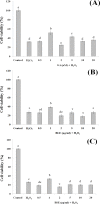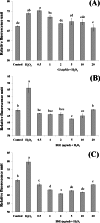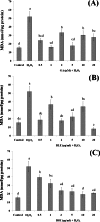Protective effects of the extracts of Barringtonia racemosa shoots against oxidative damage in HepG2 cells
- PMID: 26839752
- PMCID: PMC4734433
- DOI: 10.7717/peerj.1628
Protective effects of the extracts of Barringtonia racemosa shoots against oxidative damage in HepG2 cells
Abstract
Barringtonia racemosa is a tropical plant with medicinal values. In this study, the ability of the water extracts of the leaf (BLE) and stem (BSE) from the shoots to protect HepG2 cells against oxidative damage was studied. Five major polyphenolic compounds consisting of gallic acid, ellagic acid, protocatechuic acid, quercetin and kaempferol were identified using HPLC-DAD and ESI-MS. Cell viability assay revealed that BLE and BSE were non-cytotoxic (cell viabilities >80%) at concentration less than 250 µg/ml and 500 µg/ml, respectively. BLE and BSE improved cellular antioxidant status measured by FRAP assay and protected HepG2 cells against H2O2-induced cytotoxicity. The extracts also inhibited lipid peroxidation in HepG2 cells as well as the production of reactive oxygen species. BLE and BSE could also suppress the activities of superoxide dismutase and catalase during oxidative stress. The shoots of B. racemosa can be an alternative bioactive ingredient in the prevention of oxidative damage.
Keywords: Antioxidant enzymes; Barringtonia racemosa; HPLC-ESI-MS; Lipid peroxidation; Oxidative stress; Polyphenols.
Conflict of interest statement
The authors declare there are no competing interests.
Figures






Similar articles
-
Evaluation of Anti-proliferative Effects of Barringtonia racemosa and Gallic Acid on Caco-2 Cells.Sci Rep. 2020 Jun 19;10(1):9987. doi: 10.1038/s41598-020-66913-x. Sci Rep. 2020. PMID: 32561807 Free PMC article.
-
Polyphenols in Barringtonia racemosa and their protection against oxidation of LDL, serum and haemoglobin.Food Chem. 2014 Mar 1;146:85-93. doi: 10.1016/j.foodchem.2013.09.012. Epub 2013 Sep 11. Food Chem. 2014. PMID: 24176317
-
Polyphenols from the extract and fraction of T. indica seeds protected HepG2 cells against oxidative stress.BMC Complement Altern Med. 2015 Dec 18;15:438. doi: 10.1186/s12906-015-0963-2. BMC Complement Altern Med. 2015. PMID: 26683054 Free PMC article.
-
Antioxidant-rich leaf extract of Barringtonia racemosa significantly alters the in vitro expression of genes encoding enzymes that are involved in methylglyoxal degradation III.PeerJ. 2016 Aug 25;4:e2379. doi: 10.7717/peerj.2379. eCollection 2016. PeerJ. 2016. PMID: 27635343 Free PMC article.
-
Antioxidant and Cytotoxic Effect of Barringtonia racemosa and Hibiscus sabdariffa Fruit Extracts in MCF-7 Human Breast Cancer Cell Line.Pharmacognosy Res. 2016 Jan-Mar;8(1):66-70. doi: 10.4103/0974-8490.171104. Pharmacognosy Res. 2016. PMID: 26941539 Free PMC article.
Cited by
-
Aegle marmelos Leaf Extract Phytochemical Analysis, Cytotoxicity, In Vitro Antioxidant and Antidiabetic Activities.Plants (Basel). 2021 Nov 25;10(12):2573. doi: 10.3390/plants10122573. Plants (Basel). 2021. PMID: 34961044 Free PMC article.
-
Seasonal Variation in Essential Oils Composition and the Biological and Pharmaceutical Protective Effects of Mentha longifolia Leaves Grown in Tunisia.Biomed Res Int. 2018 Dec 9;2018:7856517. doi: 10.1155/2018/7856517. eCollection 2018. Biomed Res Int. 2018. PMID: 30627570 Free PMC article.
-
The Antiapoptosis Effect of Glycyrrhizate on HepG2 Cells Induced by Hydrogen Peroxide.Oxid Med Cell Longev. 2016;2016:6849758. doi: 10.1155/2016/6849758. Epub 2016 Nov 6. Oxid Med Cell Longev. 2016. PMID: 27891207 Free PMC article.
-
Chinese liquor extract attenuates oxidative damage in HepG2 cells and extends lifespan of Caenorhabditis elegans.Food Sci Nutr. 2020 May 23;8(7):3164-3172. doi: 10.1002/fsn3.1564. eCollection 2020 Jul. Food Sci Nutr. 2020. PMID: 32724581 Free PMC article.
-
Evaluation of Anti-proliferative Effects of Barringtonia racemosa and Gallic Acid on Caco-2 Cells.Sci Rep. 2020 Jun 19;10(1):9987. doi: 10.1038/s41598-020-66913-x. Sci Rep. 2020. PMID: 32561807 Free PMC article.
References
-
- Boulton DW, Walle UK, Walle T. Extensive binding of the bioflavonoid quercetin to human plasma proteins. Journal of Pharmacy and Pharmacology. 1998;50:243–249. - PubMed
LinkOut - more resources
Full Text Sources
Other Literature Sources
Molecular Biology Databases
Miscellaneous

